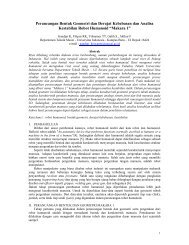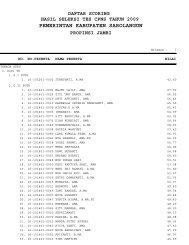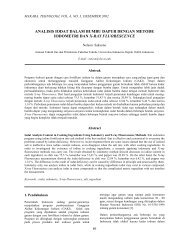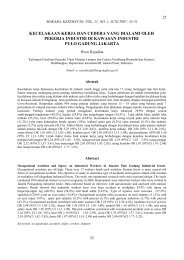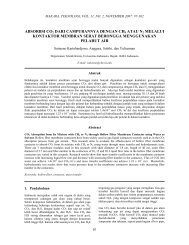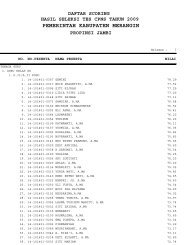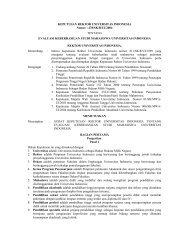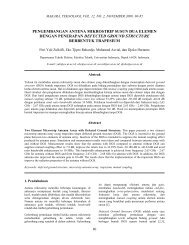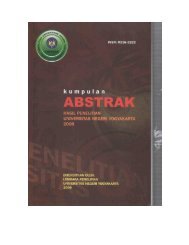“crush malaysia” campaign - Repository UI - Universitas Indonesia
“crush malaysia” campaign - Repository UI - Universitas Indonesia
“crush malaysia” campaign - Repository UI - Universitas Indonesia
Create successful ePaper yourself
Turn your PDF publications into a flip-book with our unique Google optimized e-Paper software.
MAKARA, SOSIAL HUMANIORA, VOL. 6, NO.2, DESEMBER 2002<br />
CHINA’S ROLE IN INDONESIA’S<br />
“CRUSH MALAYSIA” CAMPAIGN<br />
A. Dahana<br />
Program Studi Cina, Fakultas Ilmu Pengetahuan Budaya<br />
<strong>Universitas</strong> <strong>Indonesia</strong>, Kampus <strong>UI</strong>, Depok, 16424, <strong>Indonesia</strong><br />
E-mail: dekanfib@makara.cso.ui.ac.id<br />
Abstrak<br />
Makalah ini berargumentasi, berlawanan dengan pendapat yang umum diterima, Republik Rakyat Cina (RRC) turut<br />
serta dalam Konfrontasi <strong>Indonesia</strong> untuk mengganyang Malaysia dengan setengah hati. Malahan, berlawanan dengan<br />
propagandanya yang sangat menggebu, RRC pada dasarnya merupakan pihak yang berpartisipasi dalam konfrontasi<br />
dengan secara pasif. Gejala ini disebabkan oleh fakta bahwa pada waktu konfrontasi berlangsung Partai Komunis<br />
Malaya yang didukung Cina tengah menerapkan kebijakan yang lebih lunak terhadap pemerintah Malaysia. Tambahan<br />
lagi, RRC mungkin sekali lebih peduli terhadap nasib golongan etnik Cina di Malaysia daripada mendukung partai<br />
komunis lokal.<br />
Abstract<br />
This paper argues that contrary to the traditionally accepted opinion, the People’s Republic of China (PRC) participated<br />
in the <strong>Indonesia</strong>n <strong>campaign</strong> to crush Malaysia half-heartedly. In fact, despite its strong propaganda broadcast in<br />
supporting <strong>Indonesia</strong>, the PRC was actually a passive participant in the <strong>campaign</strong>. This is due to the fact that at that time<br />
the Chinese supported Malayan Communist Party, which was pursuing a more conciliatory policy toward the Malaysian<br />
government. Furthermore, China was probably more concerned with the well-being of ethnic Chinese Malaysia than<br />
supporting the local communist party.<br />
Keywords: Sino-<strong>Indonesia</strong>n relations, Sino-Malaysian relations, <strong>Indonesia</strong> politics and diplomacy, Chinese politics<br />
and diplomacy, Malaysian politics and diplomacy.<br />
1. Introduction<br />
Although the idea of uniting all former British colonies<br />
in the Malay Peninsula, North Borneo and Singapore<br />
was not new 1 , it was Tunku A. Rahman who first<br />
publicly announced the proposal for the establishment<br />
of the federation of Malaysia on May 27, 1961. In<br />
addition to the proposal, there was also a concept for a<br />
smaller merger between Malaya and Singapore. This<br />
idea, however, was not too popular among UMNO<br />
leaders. The inclusion of the tiny island, whose<br />
population is mostly Chinese, would certainly threaten<br />
the ethnic balance in Malaya, which was favorable to<br />
the Malays.<br />
1 Most Information in this section, unless specified,<br />
originated from Milne and Mauzy, Politics and Government<br />
in Malaysia, (Singapore: Times Books International, 1980),<br />
Chapter 4.<br />
58<br />
In the meantime, however, there were two separate<br />
developments, which pushed further the formation of<br />
Malaysia. Within the UMNO leadership emerged a<br />
belief, which came up initially in 1956 and became<br />
more established by 1960, that the indigenous people<br />
of Borneo should be considered Malays. Therefore, the<br />
inclusion of former British colonies into a federation,<br />
even if Singapore were included, would not jeopardize<br />
the ethnic balance of the new state. In the meantime,<br />
political development in Singapore in the early 1960s<br />
contributed to the hastiness of the Malaysian<br />
formation. The government of the People’s Action<br />
Party (PAP) under Lee Kuan Yew, although it tended<br />
to be left-learning, was losing the elections to the more<br />
radical faction of the party which later established its<br />
own organization, the Barisan Sosialis (Socialist<br />
Front), which was communist-oriented. In fact, since<br />
1948 when elections were introduced, the political<br />
radicalism, while the British planned to give the colony
MAKARA, SOSIAL HUMANIORA, VOL. 6, NO.2, DESEMBER 2002 59<br />
independence in 1963. The Malay leaders, being anti-<br />
Communists, were very concerned about a possible<br />
independent and communist-dominated Singapore,<br />
which would be used as a base to help their Malayan<br />
comrades (Andaya, 1982: 270–71). The possibility of<br />
Singapore becoming the “Southeast Asian Cuba” was<br />
in the minds of the anti-Communist Tunku and the<br />
British government.<br />
The formation of Malaysia, which included all British<br />
colonies in Southeast Asia with the exception of<br />
Brunei, therefore, was an escape clause from the threat<br />
of ethnic imbalance and communism. In addition, the<br />
Tunku Abdulrahman expected economic benefit from<br />
Singapore inclusion. China’s accusation that the new<br />
state was a Western-created bastion against<br />
communism in the area was, therefore, not baseless.<br />
2. Methodology<br />
This study relies mostly on information and official<br />
statements found in the Chinese media. During the<br />
period covered by this study the People’s Republic of<br />
China (PRC) was still a closed society in which<br />
everything, including all forms of mass media<br />
(newspapers, magazines, and radio broadcasts) were<br />
placed under the very tight control of the government.<br />
Some scholars, like Domes (1983: 69–83) remind us<br />
about possible “misinformation” in China’s statements.<br />
We, therefore should be careful in using those official<br />
statements. Fingar (1980) on the contrary, suggests that<br />
this consciousness should be specifically applied to<br />
such domestic policies as agriculture, economy,<br />
education and culture, and other similar matters.<br />
Unlike domestic policies, which might be distorted in<br />
the process of their creation and implementation,<br />
foreign policy is carried out under the close<br />
management of professional bureaucrats. Liao and<br />
Whiting’s study Fingar (1980) on Renmin Ribao<br />
(People’s Daily) during the Sino-Indian border crisis of<br />
1962 proves the reliability of the newspaper as a<br />
measurement of Chinese authoritative reactions to<br />
particular events. Dillon (1977:457) describe Peking<br />
Review as “an accurate and reliable indicator of official<br />
Chinese foreign policy perceptions.” Furthermore<br />
Tretiak’s (1971) close reading on news reports and<br />
analysis of Peking Review during the closing years of<br />
the Cultural Revolution indicates its reliability in<br />
predicting changes in certain areas of foreign policy.<br />
We may assume, therefore, that foreign policy<br />
statements, which are found in the Chinese media, are<br />
in accordance with the intended policy.<br />
3. Analysis and Data Interpretations<br />
3.1. <strong>Indonesia</strong>n Confrontation and China’s Support<br />
The information of Malaysia was opposed by two of its<br />
neighbors: <strong>Indonesia</strong> and the Philippines. The external<br />
and internal politics of <strong>Indonesia</strong> under Sukarno after<br />
1959 were leaning toward leftist radicalism. The<br />
Philippines opposition was based on a claim that North<br />
Borneo had historical been an area governed by the<br />
Sultan of Sulu, a region which now belongs to the<br />
Philippines.<br />
When the Malaysia concept was announced in mid-<br />
1961 <strong>Indonesia</strong> was still busy with diplomatic and<br />
armed efforts to liberate West Irian (West New Guinea<br />
or now Irian Jaya) from Dutch hands. Thus, Sukarno<br />
and other <strong>Indonesia</strong> leaders seemed not to harbor any<br />
abjection to the Malaysian formation. Marvin Ott notes<br />
that the initial negative reaction came from the PKI. He<br />
based his finding on a resolution adopted by the party<br />
in its Third Plenum of the Central Committee which<br />
condemned the Malaysian Plan as a “colonial intrigue”<br />
unacceptable to the local people, created by British<br />
colonialist to maintain their interest in the area. But<br />
after the West Irian conflict was resolved in favor of<br />
<strong>Indonesia</strong> in September 1961, even non-communist<br />
parties and leaders of <strong>Indonesia</strong> started to voice<br />
opposition to the plan (Ott, 1971). By the end of 1963,<br />
the war of words escalated into an armed conflict<br />
involving Great Britain, which, obliged by its defense<br />
agreement with Malaysia, sent its soldiers to fight the<br />
<strong>Indonesia</strong>n military intrusion.<br />
<strong>Indonesia</strong>’s confrontation came into the open when a<br />
military rebellion occurred in Brunei on December 8,<br />
1962, a British-protected sultanate in North Borneo.<br />
The leader of the uprising, A.M. Azahari, was a pro-<br />
<strong>Indonesia</strong> nationalist who believed that the inclusion of<br />
the tiny kingdom into Malaysia would hinder his<br />
nationalist goals and his personal ambition. The<br />
rebellion was easily suppressed by the British Army.<br />
Ott observes that although the rebellion was brief, it<br />
nonetheless, among other consequences, became the<br />
justification for <strong>Indonesia</strong>n opposition to the<br />
Federation of Malaysia (Ott, 1971). Indeed,<br />
<strong>Indonesia</strong>’s argument for confrontation was based on a<br />
belief that the Federation of Malaysia was formed<br />
without local consent, especially in North Borneo.<br />
<strong>Indonesia</strong>n leaders throughout the confrontation period<br />
always repeated this theme.<br />
There are so many interpretations to the background of<br />
<strong>Indonesia</strong>’s <strong>“crush</strong> Malaysia” <strong>campaign</strong>. Malaysian<br />
leaders usually referred to it as an expression of<br />
jealousy on the <strong>Indonesia</strong>n part because of Malaysia’s<br />
successes in economic development. They also viewed
60<br />
it as a manifestation of <strong>Indonesia</strong>n and Chinese<br />
communist success in embracing Sukarno (Khaw,<br />
1972: 219–20). Again; the Tunku and his supporters<br />
saw Chinese hands behind Sukarno and <strong>Indonesia</strong>’s<br />
back. Gordon (1963) regarded the confrontation as an<br />
exhibition of <strong>Indonesia</strong>’s expansionist ideology.<br />
In reality there was no simple explanation behind the<br />
<strong>Indonesia</strong>n action. Hindley (1964: 904–13) enumerates<br />
several factors. <strong>Indonesia</strong>n leadership under Sukarno<br />
had several grievances against Malaysia. They strongly<br />
believed that the Moslem rebels who threatened<br />
<strong>Indonesia</strong>’s existence in 1948-1962 were financed and<br />
aided by the West from Malaya. Malayan territories<br />
were also used to give support and asylum to leaders of<br />
provincial military rebellion in the late 1950s. They<br />
furthermore believed that the existence of Malaysia,<br />
still controlled by the British, would remain a base for<br />
subversive against <strong>Indonesia</strong>. Added to this was the<br />
failure of Malaysian leaders and the British to consult<br />
Jakarta when they planned the formation of the<br />
federation. Sukarno’s dream to make his country have<br />
a dominant status in the region was also a contributing<br />
factor. Ott (1971) added the antagonistic personalities<br />
between Sukarno and Tunku, and Malaysian<br />
displeasure over Sukarno’s pro-Beijing polities.<br />
Current argument is offered by Subritzky (2000: 1–31).<br />
He argues that Sukarno who was strongly committed to<br />
eliminate remnants of Western colonialism in Asia.<br />
Originally it was the Dutch who was the target of his<br />
<strong>campaign</strong>, but when the conflict over Irian Jaya was<br />
settled in favor of the <strong>Indonesia</strong>n claim, Sukarno<br />
turned his focus on the British, and by the beginning of<br />
1963 he directed his attention to the British plan in<br />
Malaysia. And direct opposition to it. Her alleged that<br />
the Malaysian plan was a stepping-stone for Western<br />
imperialism to continue controlling Southeast Asia.<br />
<strong>Indonesia</strong>’s experience of facing Malaya, which<br />
supported the PRRI/Permesta dissidents who were<br />
longing for separate states, exacerbated Sukarno’s<br />
suspicion. In addition Sukarno had hard feeling toward<br />
Malaysia who was abstain in UN voting regarding<br />
West Irian status. From Malaysian side, Sukarno was<br />
regarded as a dangerous leader who had a great<br />
sympathy to both <strong>Indonesia</strong>n Communist Party (PKI)<br />
as well as to China, and therefore had to be opposed.<br />
Whatever the case, the <strong>Indonesia</strong>n <strong>campaign</strong> to <strong>“crush</strong><br />
Malaysia” (Ganyang Malaysia) was notably marked by<br />
a growing closer relationship between Jakarta and<br />
Beijing.<br />
In coming to the discussion of the Jakarta-Beijing axis<br />
we must first overview the state of the relationship<br />
among U.S., the Soviet Union and China after 1960. It<br />
was apparent that approaching 1963 Sino-Soviet<br />
differences over a whole range of such important issues<br />
as ideology, the international communist movement,<br />
war and peace, the relationship among socialist states<br />
MAKARA, SOSIAL HUMANIORA, VOL. 6, NO.2, DESEMBER 2002<br />
and with non-communist countries had reached an<br />
irreconcilable phase. To make the conflict worse, in<br />
1963 the Soviet Union and the U.S., together with<br />
British signed the so-called Test Ban Treaty, an<br />
agreement were so loose and ambiguous. The<br />
signatories were not forbidden to conduct underground<br />
nuclear arms tests, not did it tie them to hold the treaty,<br />
therefore, tended to strengthen Soviet and American<br />
domination over such weapons, to the expense of such<br />
minor countries as China. Therefore, the PRC could<br />
not accept the treaty and accused the Soviet Union of<br />
colluding with America to practice nuclear hegemony.<br />
This situation and the withdrawal of Soviet economic,<br />
technical and military aid from China led Mao and his<br />
supporters to be self-reliant in domestic and foreign<br />
policies, and to the development of China’s own<br />
nuclear weapons. This was the time when the<br />
“revisionism” brand was applied to the Soviet Union<br />
and radical foreign policy was followed. Now, the<br />
“Soviet revisionist” and “U.S. imperialists” were<br />
China’s main enemies.<br />
As to how the Sino-<strong>Indonesia</strong>n axis finally came into<br />
being, Peter C. Hauswedell’s study (Hindley, 1964)<br />
gives us some insight into background. According to<br />
Hauswedell, by 1963, there were two regional conflicts<br />
considered to be threats to peace and stability in<br />
Southeast Asia: Vietnam and Malaysia. The political<br />
situation in Vietnam was developing into a full-scale<br />
military conflict involving one of the superpowers<br />
more directly. Being close to the area of conflict, China<br />
was very concerned about a possible Sino-American<br />
confrontation, as had taken place in Korea in 1950.<br />
Conscious of the superiority of the U.S., Chinese<br />
leaders advised their Hanoi Comrades to act with great<br />
cautiousness and to avoid any large-scale and frontal<br />
attack on South Vietnam.<br />
The opening of <strong>Indonesia</strong>’s confrontation, therefore,<br />
was not greatly welcomed by China. In the first place,<br />
in comparison to Vietnam, Malaysia was not as<br />
important to China’s security. The mid-1960s was a<br />
time when the “second intermediate zone” emerged in<br />
Mao’s strategic thinking. In opposing Malaysia,<br />
<strong>Indonesia</strong> was facing England, a country of<br />
“intermediate zone” which had to be courted by<br />
Beijing. In addition, China was more interested in<br />
maintaining a good relationship with London – because<br />
the British attitude toward China was different from the<br />
U.S. and because of the China’s economic and trade<br />
interests in British—controlled Hong Kong.<br />
Meanwhile, China overall interest in the region was<br />
mainly to remove any military threat from its<br />
neighbors. <strong>Indonesia</strong>’s confrontation, contrary to<br />
China’s objective, had invited a strong additional<br />
British military presence. The combination of those<br />
factors, according to Hauswedell, made the Chinese
MAKARA, SOSIAL HUMANIORA, VOL. 6, NO.2, DESEMBER 2002 61<br />
leadership hesitate in giving full support to Sukarno’s<br />
confrontation.<br />
China, however, was very eager to support the PKI in<br />
its effort to gain power in <strong>Indonesia</strong>n politics. Being<br />
the largest communist party outside the socialist bloc,<br />
the PKI was very important for China in its<br />
competition with the Soviet Union to win sympathy<br />
and support from other communist parties. As has been<br />
indicated above, the PKI was the first to sound<br />
opposition to the Malaysian plan. For the PKI and<br />
Sukarno confrontation was important, although both<br />
viewed this for different reasons. The PKI wanted the<br />
<strong>Indonesia</strong>n army, its arch-rival, to be busy with an<br />
external threat so the party could buy the time to<br />
strengthen itself for possible seizure of power. Sukarno<br />
wished confrontation would shift the army’s attention<br />
from crushing the PKI. For him, the fall of the party<br />
would also mean his demise, as later happened in<br />
September 1965. The <strong>Indonesia</strong>n army itself, being an<br />
anti-Chinese anti-Communist force, looked at the<br />
establishment of Malaysia and Singapore’s fusion into<br />
it as a formation of a Chinese-dominated country,<br />
possibly being pro-China in the long run. Some army<br />
leaders, viewed, the Malaysian project, protected under<br />
the western military shadow, as a hindrance to<br />
<strong>Indonesia</strong>’s ambition to become the dominant power of<br />
the region. The army, therefore, supported the<br />
confrontation with the understanding that it would be<br />
carried out with limited military involvement (Crouch,<br />
1978: 55–62). Thus, <strong>Indonesia</strong>’s domestic political<br />
maneuvering caused everybody, to borrow<br />
Hauswedell’s words to jump onto the “bandwagon” of<br />
the confrontation.<br />
Meanwhile, the Hanoi leadership, disregarding<br />
Beijing’s advice to act cautiously, adhered to a more<br />
radical stand against American escalation and launched<br />
an all-out war. Therefore, Hanoi’s radicalism, the<br />
PKI’s support of Sukarno’s confrontation and the<br />
Beijing-Moscow conflict moved the PRC into a more<br />
active policy in supporting <strong>Indonesia</strong>, although it was<br />
not involved militarily.<br />
Sukarno’s confrontation turned from vocal to military<br />
when a U.N. special agency, formed for the purpose of<br />
investigating whether the federation plan was<br />
supported by local people, found that the <strong>Indonesia</strong>n<br />
objection was unfounded. Sukarno’s proclamation of<br />
confrontation in September 1963 was not illogical. The<br />
Tunku announced the establishment of the Federation<br />
of Malaysia before the U.N. Commission issued its<br />
findings openly.<br />
China first propaganda support of <strong>Indonesia</strong>’s<br />
confrontation emerged in April 1963. An article, which<br />
appeared in Shijie Zhishi, commented on the<br />
publication of a white paper regarding the<br />
establishment of Malaysia on February 2, 1963. The<br />
federation, according to the article, was formed for the<br />
purpose of protecting British interests in Singapore,<br />
Brunei, Sarawak and North Borneo. It was also meant<br />
to suppress the people’s struggle for independence in<br />
the area, that is to say, “using the federation [from the<br />
state] to unify and rule” and “to divide and rule.”<br />
Moreover, the “British imperialist” was using “the<br />
independent federation” to strengthen its military<br />
presence in Southeast Asia for the purpose of further<br />
aggression. In addition, the British used the new state<br />
to maintain their economic interests in the area since<br />
British capitalist monopolized 70 percent of rubber<br />
production and 60 percent of copper and 60-70 percent<br />
of the area’s foreign trade (Bi Wen, 1963: 16).<br />
Referring to the Malaysia plan’s relationship to “U.S.<br />
imperialism” the article continued:<br />
American imperialism has great military and<br />
economic interest in the area. [Therefore] on the one<br />
hand it welcomes and supports the “Malaysian<br />
Federation,” but on the other hand it shamelessly cuts<br />
the ground from the British feet. The U.S. President<br />
Kennedy several times voiced American support for<br />
the plan “because it is a hope to protect the security<br />
of the region.” In reality, U.S. activities are squeezing<br />
the British … [because] since late 1961 [the U.S.] by<br />
using the Philippines President Macapagal proposed<br />
an “enlarged Federation of Malaysia” consisting of<br />
Singapore, Malaya, North Borneo, and the<br />
Philippines.<br />
Dagongbao (17 September 1963) called the Malaysian<br />
plan a “joint production” of “U.S. imperialist and<br />
British colonialist,” and jokingly it said, therefore, be<br />
called Mei lai Dongya—which means “America comes<br />
to [south] East Asia—instead of Malaysia.”<br />
After Sukarno’s formal announcement of his <strong>“crush</strong><br />
Malaysia” <strong>campaign</strong> in late 1963, China’s support was<br />
even more vocal. Now the Chinese media started to<br />
link American support under Presidents John Kennedy<br />
and Lyndon Johnson to establishment of the federation<br />
of Malaysia by the “British colonialist” was an<br />
exchange for the British support the just struggle of the<br />
<strong>Indonesia</strong>n people to fight “old and new colonialism”<br />
(Dagongbao, 27 March 1964). “New colonialism” was<br />
Sukarno’s favorite term in his reference to Malaysia.<br />
The People’s Daily called the Federation of Malaysia a<br />
“neo-colonialist product of British imperialism” with<br />
Washington’s blessing. Its purpose was to suppress<br />
national liberation and peace movement in Southeast<br />
Asia. At the same time, it constituted a threat to peace<br />
movements in Southeast Asia. At the same time, it<br />
constituted a threat to peace and security of the area,<br />
particularly to <strong>Indonesia</strong>. 2<br />
2 Dagongbao, 27 March 1964, see also Chao Hai, Malaixiya,<br />
Xin Zhiminzhuyi de Chanwu” [ Malaysia, A product of Neo-<br />
Colonialism], Shijie Zhishi, (19 October 1964), pp.26-27
62<br />
China’s opposition to Malaysia reached a new degree,<br />
when in November 1964 the Malaysian government<br />
announced the opening of the Nationalist Chinese<br />
government Consulate General in Kuala Lumpur.<br />
Although the announcement also emphasized that the<br />
decision “does not imply a change in Malaysian policy<br />
of recognizing neither the Kuomintang China nor the<br />
Communist China.” Beijing reacted strongly and<br />
accused Kuala Lumpur of approaching a policy of<br />
recognition of Taiwan, an act of hostility toward China.<br />
In addition, quoting the Nationalist China news<br />
agency, Beijing mentioned the existence of military<br />
cooperation between the “Jiang Gang” and the Tunku<br />
government in forming an anti-Communist front in<br />
Asia and in suppressing communist guerrilla activities<br />
in Malaya (NCNA, 1 December 1964 & SCMP 3350, 4<br />
December 1964: 37-38). China also blamed American<br />
encouragement to both Taipei and Kuala Lumpur for<br />
Taiwan’s involvement in the Malaysia dispute 3 . It was,<br />
according to China, Malaysian support American<br />
policy to create “one China and one Taiwan” and a<br />
“dirty political plot” against the PRC (Renmin Ribao, 2<br />
December 1964).<br />
<strong>Indonesia</strong>’s confrontation against Malaysia accelerated<br />
to a higher degree when in December 1964; Malaysia<br />
was elected a non-permanent member of the U.N.<br />
membership on January 7, 1965. It regarded the<br />
decision to seat Malaysia as the outcome of a situation<br />
created by colonial powers in the U.N who were<br />
against <strong>Indonesia</strong>’s principle of oposing colonialism<br />
(Boyce, 1968: 104–105). It was not suprising that<br />
China, being kept out of the international organization<br />
for so long, welcomed <strong>Indonesia</strong>’s decision. People’s<br />
Daily regarded the Malaysian sitting in the Security<br />
Council as “naked provocation and hostility toward<br />
<strong>Indonesia</strong>.” The paper suggested that the exit of<br />
<strong>Indonesia</strong> was another ample fact that the U.N.,<br />
dominated by “U.S. imperialism,” acted as a “tool for<br />
aggression.” 4 In reference to Sukarno’s speech after his<br />
withdrawal, the paper said: Sukarno correctly said that<br />
the crown of real freedom does not lie in being a<br />
member of the United Nations. A country, which<br />
cannot stand its own feet, is not a free and independent<br />
country even if it is a member of the United Nations.<br />
“Malaysia” is an accurate example [of the principle]<br />
(Renmin Ribao, 11 January 1965). Thus, Malaysia was<br />
singled out as an example of a country without full<br />
independent. Another article in Shijie Zhishi described<br />
3 “Jielu Meiguo Cedong Jiang Bangshen Shenru Malaixiya<br />
de Yinmou” [Unveil the American-instigated Plot to Include<br />
Jiang Cligue Into The Malaysian Plot], Renmin Ribao,<br />
editorial, 2 December 1964.<br />
4 “Jianjue Zhizhi Yindunixiya Tuichu Lianheguo”<br />
[Resolutely Support <strong>Indonesia</strong>’s Withdrawal from the United<br />
Nations]. Renmin Ribao, editorial, 11 January 1965.<br />
MAKARA, SOSIAL HUMANIORA, VOL. 6, NO.2, DESEMBER 2002<br />
Malaysia as a “U.S. imperialism tool” in its scheme to<br />
“use Asians to fight Asians” (Ge Geng, 1965: 15–16).<br />
The close ties between <strong>Indonesia</strong> and China during<br />
1963-1965 were forged at a time when both countries<br />
were internationally isolated. Most neutral countries<br />
resented <strong>Indonesia</strong>’s growing radicalism on the<br />
questions of Malaysia. China, in the meantime, was<br />
also isolated by the western powers and among the<br />
neutralists, while its dispute with the Soviet Union<br />
estranged it as well from the eastern bloc, with the<br />
exception of Albania. Mozingo (1976) described the<br />
Sino-<strong>Indonesia</strong>n relationship as an attempt to establish<br />
a “third force strategy.” The purpose was to oppose<br />
both the U.S and the Soviet Union. Internationally, the<br />
period was specifically marked by Sukarno’s efforts,<br />
since his withdrawal from the U.N., to form the “New<br />
Emerging Forces” (NEFO) to oppose the “Old<br />
Established Forces (OLDEFO). For that purpose<br />
Sukarno wanted to form the conference of the New<br />
Emerging Forces (CONEFO) as an alternative to the<br />
U.N. As for the China’s part, it tried to form an<br />
international united front against a status quo, which<br />
was coerced by America and the Soviet Union. The<br />
support given by China to <strong>Indonesia</strong>’s confrontation<br />
against Malaysia was a manifestation of the close Sino-<br />
<strong>Indonesia</strong> cooperation. However, the sudden<br />
turnaround following the September 30 affair in 1965,<br />
with the crushing of the PKI and leftist elements in<br />
<strong>Indonesia</strong> including Sukarno, the confrontation came to<br />
a sudden stop, while the Sino-<strong>Indonesia</strong>n axis<br />
disintegrated. <strong>Indonesia</strong> officially terminated the<br />
confrontation in 1966. The PRC, however, continued to<br />
oppose Malaysia due to political developments in<br />
China during the Cultural Revolution.<br />
3.2. China’s Continuation of Confrontation<br />
The sudden political change in <strong>Indonesia</strong> after the<br />
September 30, 1965 Affair, followed by Sukarno’s fall<br />
and the purges of the PKI and other leftist elements,<br />
caused the sudden stop of <strong>Indonesia</strong> confrontation<br />
against Malaysia. Although initially reluctant to join in<br />
the Malaysian conflict, the PRC was now left alone to<br />
continue the confrontation. Regarding <strong>Indonesia</strong>’s<br />
discontinuation of the struggle against Malaysia,<br />
Beijing accused the Jakarta’s decision to be a result of<br />
“U.S. and British imperialist” persuasion and pressure<br />
on the <strong>Indonesia</strong> “right wing military regime” (NCNA,<br />
2 June 1966) As in the past, in reference to the<br />
Federation of Malaysia, China continued to use such<br />
derogatory terms as “the so-called Malaysia,” or to put<br />
the world “Malaysia” within quotation marks and in<br />
other ways insinuate the new state’s non-existence.<br />
On the diplomatic front, to fill the gap left by<br />
<strong>Indonesia</strong>, China welcomed the establishment of the<br />
“Permanent Mission of the Malayan National
MAKARA, SOSIAL HUMANIORA, VOL. 6, NO.2, DESEMBER 2002 63<br />
Liberation League” (MNLL) in Beijing on January 12,<br />
1966. According to P.V. Sharma, possibly a<br />
Singaporean or Malaysian India, who acted as the<br />
chairman of the mission, the MNLL was united front<br />
organization representing various Malayan and<br />
Singaporean “People’s movement at home and abroad”<br />
in struggle to <strong>“crush</strong> Malaysia” in order to achieve<br />
“true independence, democracy and peace in Malaya.”<br />
Following China’s rhetoric, Sharma also indicated that<br />
the Malayan people had learned from their experience<br />
that to free themselves from the rule of imperialism<br />
and its “puppets,” the act of “revolutionary violence”<br />
was the only answer to “counter-revolutionary war”<br />
(Renmin Ribao, 13 January 1966). Kang Yonghe, the<br />
Vice Chairman of the Chinese Commission for Afro-<br />
Asian Solidarity, who gave a welcoming reception to<br />
the Malaysian organization, pledged that the Chinese<br />
people would continue to support the Malayan people’s<br />
persistent struggle against “U.S. and British<br />
imperialists” and their “lackeys.” Referring to the<br />
Malayan people’s fight to <strong>“crush</strong> Malaysia,” Kang<br />
called it a part of the struggle of the peoples all over<br />
the world to oppose imperialism, colonialism and neocolonialism.<br />
5 On February 1, 1966, in another Beijing<br />
reception, Sharma announced that the Malayan<br />
people’s struggle was entering its eighteenth year,<br />
while he also mentioned that various organizations<br />
under the MNLL condemned the “Soviet revisionists”<br />
who cooperate with the U.S. and its “running dogs” in<br />
splitting the anti-imperialists forces. Therefore, the<br />
Malayan people would always strongly fight against<br />
“modern revisionism (Renmin Ribao, 2 February<br />
1966).” Sharma’s and Kang’s statements revealed that<br />
in alluding to the local government officials in<br />
Malaysia (and Singapore) both Malayan and Chinese<br />
communists, up to the mid-1960s, still refrained from<br />
mentioning those Malaysian official’s by name. In May<br />
1966, when the PRC successfully tested its first nuclear<br />
explosion, Sharma sent a congratulatory note on the<br />
occasion. He said the China’s new weapon gave<br />
“added impetus” to the Malayan people in their<br />
struggle to <strong>“crush</strong> Malaysia” as the British and U.S.<br />
“neo-colonial product.” At the same time, the<br />
explosion had “internationally broken the American<br />
and Soviet monopoly over nuclear arms” (NCNA, 19<br />
May 1966 & SCMP 3705, 25 may 1966: 26-27).<br />
Entering 1967 China was in the midst of the Cultural<br />
Revolution. Showing his pro-China stand, in a<br />
reception to commemorate the “18 th anniversary of the<br />
struggle of the Malayan people,” Sharma said:<br />
“From our revolution practice the Malayan people<br />
fully realized that Mao’s thought is the compass<br />
guiding us toward victory. We, Malayan people, hail<br />
the history successes of the Red Guards, workers,<br />
peasant, soldiers, revolutionary students and<br />
5 Renmin Ribao, 13 January 1966, see also Renmin Ribao, 23<br />
June 1966 for the same statement by Kang Yonghe.<br />
intellectuals have already achieved and will continue<br />
to achieve in the course of the Cultural Revolution”<br />
(NCNA, 1 February 1967, & SCMP 1806, 7<br />
February1967: 32).<br />
Again, indicating his pro-China posture in the Sino-<br />
Soviet conflict, he also accused the “Soviet revisionist”<br />
who has openly supported Malaysia. Even when<br />
Singapore released itself from the federation and<br />
gained its own “independence,” the “Soviet<br />
revisionist” lost no time in embracing the “Lee Kuan<br />
Yew puppet” and its “new type of colony” (NCNA, 19<br />
May 1966 & SCMP 3705, 25 May 1967: 32–33).<br />
The year 1967 was a time when indications emerged in<br />
Malaysian foreign policy that it was moving form right<br />
to center. This began when Malaysia together with<br />
other countries formed the Association of Southeast<br />
Asia Nations (ASEAN) in 1967. One year later<br />
Malaysia forwarded a proposal to make Southeast Asia<br />
a neutral zone (to be discussed in Chapter IX). The<br />
declaration of the ASEAN formation followed the<br />
ratification of the Bangkok Declaration on August 8,<br />
1967 by representative from <strong>Indonesia</strong>, Malaysia, the<br />
Philippines, Singapore and Thailand. The next day<br />
Xinhua reacted very strongly by accusing the<br />
association of being a “new anti-China, anti communist<br />
alliance,” formed under the order of “U.S.<br />
imperialism.” The Chinese news agency also said that<br />
the economic, social, administrative, technical, and<br />
scientific cooperation, which was mentioned by the<br />
Bangkok Declaration, was only a cover to its actual<br />
objectives, namely, to act as a part of the U.S.<br />
imperialism ring to encircle China. Thus, ASEAN was<br />
none other than the “twin brothers” of SEATO (NCNA,<br />
9 August 1967 & SCMP 4000, 14 August 1967). People<br />
Daily added another accusation that ASEAN was a<br />
joint-defense organization to meet “China’s threat.”<br />
Therefore, since SEATO existed only in name,<br />
ASEAN was another variant of SEATO 6 .<br />
Toward the end of 1967 China’s propaganda against<br />
Malaysia was included in its quarrel with the Russians.<br />
In October the Tunku announced the Malaysian<br />
intention to open diplomatic relations with the Soviet<br />
Union. People Daily, while reminding readers that<br />
Malaysia was a “product manufactured by the U.S. and<br />
British colonialism-imperialism” to sabotage the<br />
national liberation movement in Southeast Asia, also<br />
said that: The Soviet revisionist clique’s opening<br />
relations with “Malaysia” is not difficult to understand,<br />
[because] for years they have been trying to make<br />
friends with U.S. imperialist lackeys and running does<br />
in Asia. The purpose is to strengthen their counterrevolutionary<br />
collusion with U.S. imperialism in order<br />
6 “Meidi Zougou de Fangeming Xiao Lianmeng” [A Small<br />
Counter-revolutionary Association of U.S. Imperialist<br />
Running Dogs], Renmin Ribao (Editorial), 12 August 1967.
64<br />
to encircle China and also to realize their own type of<br />
neo-colonial-ism. At the same time it was not a<br />
coincidence that the Rahman reactionary group wants<br />
to cooperate with Soviet revisionist clique [to oppose<br />
China] (Renmin Ribao, 22 October 1967).<br />
The opening of Malaysian-Soviet relations marked the<br />
increasing resentment of China toward Malaysia. Now,<br />
both the MNLL’s and PRC’s propaganda directly<br />
called the Malaysian and Singaporean governments as<br />
“Rahman-Lee puppets,” “cliques,” or “running dogs.”<br />
Commenting on the visit of Foreign Minister Tun<br />
Abdul Razak to the Soviet Union in mid-1968, the<br />
People’s Daily, quoting MNLL’s organ the Malayan<br />
Bulletin, called the visit a clear sign of the<br />
strengthening of “counter-revolutionary cooperation”<br />
between the “Soviet revisionists and the Malaysian<br />
puppets” (Renmin Ribao, 28 June 1968). Xinhua, again<br />
quoting the Malayan Bulletin, charged that Soviet<br />
intrusion into Southeast Asia by forging a close<br />
relationship with Malaysia was caused by its fear of<br />
China’s high prestige and the influence of Mao’s<br />
thought in the region, which was being followed by the<br />
revolutionary Malayan and Southeast Asian Peoples<br />
(NCNA, 27 June 1968). Another article publishing by<br />
Xinhua in early 1968 clearly accused Malaysia of being<br />
the puppet of England, the U.S. and the Soviet Union,<br />
and therefore, should be eliminated.<br />
Malaya [including Singapore] continues to be a British<br />
new-type colony to this day, and due to the decline of<br />
British imperialism, the danger of U.S. imperialism<br />
replacing it in enslaving the Malayan people is<br />
becoming graver. The Soviet revisionist is stepping up<br />
their collusion with Rahman-Lee puppet groups in the<br />
attempt to undermine the Malayan people’s<br />
revolutionary struggle. Hence, to eliminate the<br />
influence of British imperialism, which is aided by<br />
Soviet modern revisionists, the Malayan people must<br />
overthrow the Rahman-Lee puppet regimes (Renmin<br />
Ribao, 20 January 1969).<br />
Since early 1969, China’s propaganda attacked the<br />
Soviet Union’s change of policy to Malaysia. Only two<br />
years ago charged the People’s Daily in February<br />
1969, the Soviet Union accused Malaysia as being an<br />
“imperialist-created puppet state.” Now, on the<br />
contrary, the “Soviet revisionist” had pledged to<br />
cooperate with that “puppet state.” 7 By the end of<br />
1969, for Chinese propaganda, Malaysia had become<br />
the project of collusion among Chinese enemies on all<br />
fronts to suppress “people” and to oppose China.<br />
Commenting on the expansion of Malaysian armed<br />
forces, Xinhua argued:<br />
7 NCNA, 4 September 1969, in Foreign Broadcast<br />
Information Service (FBIS), DR, CC, 1.172 (5 September<br />
1969), pp A12-13.<br />
MAKARA, SOSIAL HUMANIORA, VOL. 6, NO.2, DESEMBER 2002<br />
The Rahman-Razak puppet clique’s military<br />
expansion has had the support of the Soviet<br />
revisionists. Social – imperialists, and the British<br />
imperialism. Malayan papers disclosed that Soviet<br />
revisionism actually helped the Rahman-Razak<br />
puppet clique to reorganize the navy and expand the<br />
air force and is preparing to provide artillery, tanks,<br />
and airplanes and other modern weapon to equip the<br />
reactionary troops of “Malaysia,” together with a<br />
large sum of money as military aid to the puppet<br />
clique. British imperialists with its accomplices,<br />
Australian and Indian reactionary have in the past<br />
few months been shipping small arms (NCNA, 23<br />
February 1968 & SCMP 4126, 27 February 1968:<br />
30).<br />
It is interesting to note that most Chinese media’s<br />
references to Malaysia were taken from other sources,<br />
especially various bulletins published by the MNLL in<br />
Beijing and by underground communist newsletter in<br />
Malaysia and Singapore. Those sources tended to<br />
exaggerate and even to falsify the facts. In reality there<br />
is no evidence to support Beijing’s allegations that<br />
Moscow, as early as 1969, had supplied or was ready<br />
to supply Malaysia with arms and military equipment.<br />
The anti-Communist Tunku’s influence in 1969 was<br />
still great and unchallenged openly. In addition, most<br />
of Malaysia’s military hardware originated from<br />
Britain, America and other Western countries.<br />
3.3. The Cultural Revolution and the MCP<br />
Except for references to the activities and statements of<br />
the MNLL in Beijing under Sharma which always<br />
upheld armed struggle under the guidance of Mao’s<br />
Thought as the guiding principle to fight against<br />
imperialist “lackeys” and to “Crush the puppet state<br />
Malaysia,” the Chinese media throughout 1966 and<br />
1967 did not cover many MCP activities. Even in<br />
reporting those activities, Chinese newspapers relied<br />
mostly on new bulletins and statements issued by the<br />
MNLL and underground newspapers published by anti-<br />
Malaysian fighters in Singapore and Malaysia. 8<br />
Political developments in Singapore and Malaysia,<br />
however, changed the fates of two leftist organizations<br />
during confrontation. In Singapore, the pro-Beijing<br />
Barisan Sosialis suffered a stunning defeat. The party<br />
policy’s of parroting Chinese (and <strong>Indonesia</strong>n) slogans<br />
as <strong>“crush</strong> Malaysia” and “phoney independence”<br />
alienated its constituents. General opinion considered<br />
the party to be the “voice of Peking,” and therefore, its<br />
popular support eroded. In Malaysia the left – leaning<br />
Socialist Front suffered the same defeat, caused mainly<br />
by a breakup within its leadership. The Malaysian<br />
party was a fusion between Malay leftist socialist and<br />
8 See for example, Peking Review, 7 (11 February 1966), p.4;<br />
Renmin Ribao, 13 January 1966, 2 February 1966, 23 June<br />
1966, 12 December 1967.
MAKARA, SOSIAL HUMANIORA, VOL. 6, NO.2, DESEMBER 2002 65<br />
Chinese labor Organizations. In February 1966, both<br />
factions decided to seek the their own ways (Pillai,<br />
1966). Although the Malaysian party was against the<br />
creation of Malaysia, and thus, in line with <strong>Indonesia</strong>’s<br />
and China’s policy, communalism hindered its unity. It<br />
was also apparent that <strong>Indonesia</strong>’s abandonment of<br />
confrontation has left the future of the <strong>“crush</strong><br />
Malaysia” <strong>campaign</strong>s a big question mark. In the<br />
meantime, in spite of Beijing’s cultural revolutionary<br />
massive propaganda and reports on the opposition of<br />
the people to the “Puppet State Malaysia,” the MCP,<br />
which was mainly active in the Thai-Malaysian border,<br />
was not quick to adopt radicalism as preached from<br />
Beijing. Taylor assumes that there might have been an<br />
internal conflict within the party on the issues of armed<br />
struggle. Chin Peng might have been reluctant to<br />
follow radical policy, while there were others within<br />
the leadership who preferred to follow China’s<br />
directives (Taylor, 1974: 312–12). Just a during the<br />
1963-1965 period when <strong>Indonesia</strong>, backed by China,<br />
was still actively following a confrontational policy,<br />
China did not report the activities of the communist in<br />
West Malaysia. Its reports on confrontation against<br />
Malaysia still concentrated on armed struggle in North<br />
Borneo.<br />
The MCP’s first answer to the Chinese Cultural<br />
Revolutionary call for world revolution came in mid-<br />
December 1967. People’s Daily, quoting the<br />
underground Malaysian paper Malayan Herald<br />
reported that the MCP, which followed Marxism-<br />
Leninism (a key word for China’s path in the Sino-<br />
Soviet conflict), always “raises high the red banner of<br />
Mao’s Thought,” All member of the party, according to<br />
the article, were diligently studying the teaching of<br />
Mao, because all guerilla fighters of Malayan People’s<br />
Liberation Army (MNLA) were always listening<br />
carefully to the broadcasts on Mao’s Thought via<br />
Radio Beijing (Renmin Ribao, 12 December 1967). In<br />
addition, Malayan Bulletin, the organ of the MNLL in<br />
Beijing in mid-February 1968 described the situation in<br />
“guerilla zones” near the Thai-Malaysian border. The<br />
report was full of praise of Mao’s Thought and Maoist<br />
rhetoric.<br />
Inspired by Mao’s Thought, The MNLA and people<br />
in guerilla zones fight heroically and tenaciously ...<br />
smashed the offensive of the U.S. backed British<br />
imperialist and the Malaya puppet clique’s attack on<br />
the Malay-Thai border regions and guerrilla zones in<br />
North Malaya … In all those struggles the broad<br />
masses of the people manifested a spirit of daring to<br />
struggle and to win. Although in almost every<br />
instance they met with broad masses of the people<br />
who do not fear imprisonment, injury or sacrifice,<br />
battle the armed troops and police of the enemy. The<br />
mass struggles have proved that the Rahman–Lee<br />
cliques are paper tigers (NCNA, 23 February 1968 &<br />
SCMP 4126, 27 February 1968: 29-30).<br />
Reminiscences of Chinese communist experience<br />
during the war against Japan and the Chinese<br />
Nationalist was shown when the report mentioned that<br />
the government of the guerrilla zones were all carrying<br />
out land economic system as a means to be self –<br />
governed and self – supported (NCNA, 23 February 1968<br />
& SCMP 4126, 27 February 1968: 29-30). On June 1,<br />
1968, which was the twentieth anniversary of<br />
communist rebellion in Malaya, the MCP issued a<br />
statement on the resurgence of its armed struggle was<br />
based on a principle of “using revolutionary armed<br />
strength against counter-revolutionary armed strength,”<br />
and “surrounding the cities from the countryside”<br />
(Guangmin Ribao, 19 June 1968)<br />
China answers MCP’s call with a CCP congratulatory<br />
note on the twentieth anniversary of communist<br />
struggle in Malaya. The letter supported the MCP’s<br />
decision to reactive armed struggle as propagated by<br />
China.<br />
The CCP believes that the MCP, which has gone<br />
trough the fierceness of battle experience and has<br />
been hardened by fighting encounters will combine<br />
the universal truth Marxism, Leninism and Mao<br />
Zedong’s Thought with concrete conditions in<br />
Malaya. [The party will] firmly hold to the red banner<br />
of the armed struggle, unite closely with all Malayan<br />
races, develop and continue armed struggle and will<br />
lead the Malayan people to rid British imperialism<br />
and U.S. aggressors [in its efforts] to overthrow the<br />
Rahman-Lee puppet cliques and to established a new<br />
and independent Malaya [based on] unity and<br />
democracy (Renmin Ribao, 30 June 1968).<br />
The Malaysian government confirmed the resurgence<br />
of communist-armed struggle by the publication of a<br />
white paper in 1971. It interpreted the MCP’s return to<br />
violent revolution as the party’s admittance of failure<br />
and the defeat of so-called “open and legal struggle,” 9<br />
which had been in effect since the late 1950s.<br />
According to the Malaysian government, communist<br />
small-armed groups crossed the Thai-Malaysian border<br />
and carried out terrorist activities directed toward local<br />
people. The purpose was to dramatize their comeback<br />
and their capabilities as well as constitute propaganda<br />
to attract their supporters. 10<br />
Since mid-1968, therefore, Chinese propaganda<br />
included West Malaysia as one of the areas where<br />
“people’s armed struggles” were going on. Xinhua<br />
reports on the development of those “people’s<br />
revolutions” mentioned various successes gained by<br />
the MNLA in repulsing the enemy’s attacks and in<br />
“annihilating” their armed forces. The successes of the<br />
MNLA, according to Xinhua, were due to the support<br />
9 The Resurgence of Armed Communism in West Malaysia<br />
(Kuala Lumpur: Ministry of Home Affairs, 1 October 1971),<br />
p.1.<br />
10 Ibid., p.5
66<br />
of the people (NCNA, 26 September 1968, & SCMP, 2<br />
October 1968: 29).<br />
The cultural Revolutionary period in China was<br />
marked by call from Beijing to revolutionaries around<br />
the world, especially in Asia, Africa and Latin America<br />
to raise arms to oppose and overthrow all<br />
“reactionaries.” This call was especially strong after<br />
the publication of Lin Biao’s famous article “Long<br />
Live the Victory of People’s War” in September 1965.<br />
Lin Biao’s thesis specifically called the use of<br />
“surrounding the cities from the countryside” strategy<br />
as applied by China during its revolutionary war in the<br />
1930s and 1940s in world revolution. The late defense<br />
minister and soon to be, for a time, their apparent to the<br />
chairman theorized that revolutions in developing<br />
countries (Asia, Africa, and Latin America) as the<br />
world’s countryside were the first step toward further<br />
revolutions in the developed areas of the world, which<br />
according to Lin were world’s cities. 11 Malaysian<br />
communist rhetoric also followed Lin Biao’s analysis.<br />
An article in the Malaya Bulletin which was later<br />
published by the Chinese media described the<br />
revolutionary situation in Malaya in mid-1968 as<br />
victorious for the Malayan people in their struggle to<br />
oppose Malaysia and Singapore which were “British<br />
new type” colonies, aided by U.S. imperialism and<br />
Soviet revisionist”(Peking Review, 8 March 1968: 35)<br />
In discussing how Malayan revolutionaries should act,<br />
the article, although it did not mention Lin Biao,<br />
stressed the importance of his theory.<br />
… in order to win victory it is imperative to persist in<br />
the path of using the countryside to encircle the cities<br />
and seizing political power by armed force, to oppose<br />
the counter-revolutionary armed forces of the U.S.,<br />
and British imperialist and their running dogs with<br />
revolutionary armed forces and to oppose the unjust<br />
colonial war of the imperialists and their running<br />
dogs with the just war of national liberation (Peking<br />
Review, 8 March 1968: 35).<br />
Since 1968, therefore, in its propaganda against<br />
Malaysia, in addition to reports on guerrilla<br />
11 Lin Biao, “Long Live the Victory of People’s War,”<br />
Peking Review, 36 (3 September 1965), pp. 9-39, especially<br />
pp. 22-25 on the applicability of the “people’s war”<br />
internationally. The publication of Lin Biao’s article<br />
coincided with American military escalation in Vietnam. It is<br />
therefore generally believed that Lin referred mostly to the<br />
strategy and tactics of facing the U.S. in Vietnam. Although<br />
Lin preached the importance of Mao’s theory of people’s war<br />
as the most appropriate strategy and tactics to use in<br />
revolutionary struggles in the less developed areas, he also<br />
emphasized the importance of “self reliance” as the basic<br />
principle for those revolutions. Cf. David Mozingo, An<br />
Interpretation of Lin Biao’s September 3 Article (Santa<br />
Monica: The Rand Corporation, 1965); David Mozingo,<br />
Thomas W. Robinson, Lin Biao on “People’s War”: China<br />
Takes A Second Look Into Vietnam (Santa Monica: The Rand<br />
Corporation, 1965).<br />
MAKARA, SOSIAL HUMANIORA, VOL. 6, NO.2, DESEMBER 2002<br />
movements in North Borneo and the opening of the<br />
communist rebel’s representative office in Beijing,<br />
the activities of the resurgent MCP were also<br />
included in Chinese coverage. 12<br />
By the end of 1969 the Chinese propaganda war<br />
against Malaysia reached a new point. On November<br />
23, 1969 the Malayan Communist underground<br />
newspaper, Barisan, declared in its editorial the<br />
inauguration of the Voice of Malayan Revolution<br />
(Suara Revolusi Malaya – VOMR), a radio station<br />
whose primary task was to propagate the “great Mao<br />
Zedong Thought and the struggle of the MCP and the<br />
[Malayan] people.” The establishment of the radio<br />
station, according to the underground paper, was based<br />
on the reason that in their oppression of the people,<br />
“imperialism and reactionaries” in Malaya for a long<br />
time had been using radio broadcast to spread counterrevolutionary<br />
propaganda. Thus, VOMR was a tool to<br />
“disseminate revolution in order to defeat counterrevolution”<br />
(Guangming Ribao, 5 December 1969).<br />
Reacting to the newly established VOMR, Tunku A.<br />
Rahman accused that the radio station was located in<br />
Yunnan province in South China (Asian Analyst,<br />
January 1970:13).<br />
The establishment of the VOMR was a part of China’s<br />
propaganda program during the Cultural Revolution<br />
period. In addition to VOMR, Beijing also formed the<br />
Voice of the People of Thailand, another radio station<br />
to give propaganda support to the “people’s war” in<br />
that country.<br />
4. Conclusion<br />
The writer of this paper argues that contrary to the<br />
traditionally accepted opinion The People’s Republic<br />
of China participated in the <strong>Indonesia</strong>n <strong>campaign</strong> to<br />
crush Malaysia half-heartedly. 13 In fact despite its<br />
strong propaganda broadcast in supporting <strong>Indonesia</strong>,<br />
the PRC was actually a passive participant in the<br />
program. This is due to the fact that the Chinese<br />
supported Malayan Communist Party at that time was<br />
pursuing a more conciliatory policy toward the<br />
Malaysian government. In addition China was<br />
probably worried that bad relations with Malaysia<br />
would affect the well-being of ethnic Chinese in<br />
Malaysia. Seen from strategic basis, the attitude of the<br />
Chinese was based on Mao’s teaching that in a<br />
12 See for example: NCNA, 25 April 1968 (SCMP, 4166, 29<br />
April 1968, p.28); NCNA 28 April 1968 (SCMP, 4167, 30<br />
April 1968, pp.26-27); NCNA, 11 December 1968 (SCMP,<br />
4320, 17 December 1968, p.23); NCNA, 28 December 1968<br />
(FBIS, 1.7 20 January 1969, pp. A2-3); NCNA, 12 February<br />
1968 (FBIS, 1.29, 12 February 1969, pp. A3-4); Peking<br />
Review, 9 (28 February 1969, p.19).<br />
13 This paper is a part of the writer’s dissertation presented to<br />
the Graduated Division University of Hawaii, 1986. The<br />
writer has added more current information to the paper.
MAKARA, SOSIAL HUMANIORA, VOL. 6, NO.2, DESEMBER 2002 67<br />
revolutionary war, the revolutionary army should not<br />
face two enemies at the same time. At that time the<br />
Chinese was supporting The Malayan Communist<br />
Party, which was raising arms against the Malaysian<br />
government and operating in the border area of<br />
Malaysia and Thailand.<br />
In the meantime, although the PRC was pursuing a<br />
radical diplomacy, the MPC was basically taking peace<br />
offensive tactic. Furthermore, the MCP after 1960 was<br />
already in a defensive position and was not regarded by<br />
both the Malayan government and the British<br />
administration as a serious threat. Facts in this paper<br />
show that the increasing hostility between <strong>Indonesia</strong>,<br />
supported by China, and Malaysia, supported by the<br />
West, did not automatically increase the activities of<br />
the rebellious MCP.<br />
References<br />
Andaya, Barbara B. and Leonard W. Andaya. 1982. A<br />
History of Malaysia. New York: St. Martin’s Press.<br />
Asian Analyst, January 1970<br />
Bi Wen. 1963. “Malaixiya Lianbang Jihua Poushe”<br />
[Dissect the Federation of Malaysia Plan] in Shijie<br />
Zhishi 7 (10 April 1963).<br />
Boyce, Peter. 1968. “<strong>Indonesia</strong>’s withdrawal from the<br />
United Nation’s: Letter from Foreign Minister to<br />
Secretary General, 20 January 1965,” in Malaysia and<br />
Singapore in International Diplomacy. Sydney:<br />
Sydney University Press.<br />
Chao Hai. 1964. “Malaixiya, Xin Zhiminzhuyi de<br />
Chanwu” [Malaysia, A product of Neo-Colonialism],<br />
Shijie Zhishi, (19 October 1964).<br />
Crouch, Harold.1978. The Army and Politics in<br />
<strong>Indonesia</strong>. Ithaca: Cornell University Press.<br />
Dagongbao<br />
17 September 1963<br />
27 March 1964<br />
Dillon, Linda D., B. Burton and W. C. Sodelund. 1977.<br />
“Who was the Principal Enemy?: Shifts in Official<br />
Chinese Perception, 1968-1969” in Asian Survey 17.5<br />
(May 1977).<br />
Domes, Jurgen. 1983. “Misinformation and<br />
Misconception about China in Western Political<br />
Science, 1966-1978”, in Methodological Issues in<br />
China Studies. Edited by Amy A. Wilson, Sydney L.<br />
Greenblatt & Richard W. Wilson. New York: Praeger.<br />
Fingar, Thomas. 1980. “Domestic Policy and the Quest<br />
for Independence”, in China’s Quest for Independence:<br />
Policy Evolutions in the 1970’s. Thomas Fingar;<br />
Stanford Journal of International Studies (eds.).<br />
Boulder: Westview Press.<br />
Foreign Broadcast Information Service (FBIS)<br />
DR, CC, 1.172, 5 September 1969; Vol. 1.7, 20 January<br />
1969; Vol. 1.29, 12 February 1969<br />
Ge Geng. 1965. “Malaixiya shi Shenmo Huose?”<br />
[What kind of Rubbish is Malaysia?], Shijie Zhishi, 6<br />
(25 March 1965)<br />
Gordon, Bernard K. 1963. “The Potential for<br />
<strong>Indonesia</strong>n Expansionism,” in Pacific Affairs, 36.4,<br />
(Winter 1963-1964).<br />
Guangmin Ribao, 19 June 1968<br />
Hindley, Daonld.1964. “<strong>Indonesia</strong>’s Confrontation<br />
with Malaysia: A Search for Motives,” Asian Survey,<br />
4.6 (June 1964).<br />
Khaw Guat Hoon. 1972. “Malaysian Policies in<br />
Southeast Asia, 1957-1970: The Search for Security.”<br />
Doctoral Dissertation University of Geneva.<br />
Lin Biao. 14 1965. “Long Live the Victory of People’s<br />
War,” Peking Review, 36 (3 September 1965)<br />
Milne, R. S. and Diane K. Mauzy. 1980. Politics and<br />
Government in Malaysia. Singapore: Times Books<br />
International.<br />
Mozingo, David. 1976. Chinese Policy Toward<br />
<strong>Indonesia</strong>, 1949-1967. Ithaca: Cornell University<br />
Press.<br />
New China News Agency (NCNA)<br />
1 December 1964; 19 May 1966; 2 June 1966; 1<br />
February 1967; 9 August 1967; 12 February 1968; 23<br />
February 1968; 25 April 1968; 28 April 1968; 27 June<br />
1968; 4 September 1969; 26 September 1968; 11<br />
December 1968; 28 December 1968<br />
Ott, Marvin.1971. “The Sources and Content of<br />
Malaysian Foreign Policy Toward <strong>Indonesia</strong> and the<br />
Philippines.” Ph.D. Dissertation, The John Hopkins<br />
University.<br />
Peking Review<br />
Vol. 7, 11 February 1966; 8 March 1968; Vol. 9, 28<br />
February 1969.<br />
Pillai, K.S. 1966. “Peking’s Threat to ‘Liberate’<br />
Malaysia,” South China Morning Post, 4 February<br />
1966.<br />
Renmin Ribao<br />
2 December 1964; 11 January 1965; 13 January 1966;<br />
2 February 1966; 23 June 1966; 12 August 1967; 22<br />
October 1967; 12 December 1967; 28 June 1968; 30<br />
June 1968; 20 January 1969<br />
Selection of China Mainland Press (SCMP)<br />
Vol. 3350, 4 December 1964; Vol. 3705, 25 May 1966;<br />
Vol. 1806, 7 February 1967; Vol. 4000, 14 August<br />
14<br />
See Lin Piao (old Wade-Giles spelling), or Lin Biao (Pin<br />
Yin).
68<br />
1967; Vol. 4126, 27 February 1968; Vol. 4166, 29<br />
April 1968; Vol. 4167, 30 April 1968; 2 October 1968;<br />
Vol. 4320, 17 December 1968<br />
Subritzky, John. 2000. Confronting Sukarno: British,<br />
Australian, and New Zealand Diplomacy in the<br />
Malaysian-<strong>Indonesia</strong>n Confrontation, 1961-1965. New<br />
York: St Martin Press.<br />
MAKARA, SOSIAL HUMANIORA, VOL. 6, NO.2, DESEMBER 2002<br />
Taylor, Jay. 1974. China and Southeast Asia: Peking’s<br />
Relations with Revolutionary Movements. New York:<br />
Praeger Publishers.<br />
Tretiak, Daniel. 1971. “Is China Trying to Turn Out?:<br />
changes in Chinese Level of Attention to the<br />
International Environment”, in Asian Survey, 11.3<br />
(March 1971).



